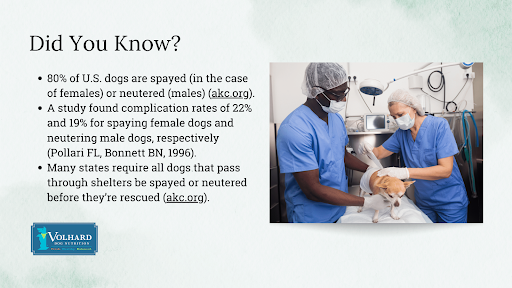When Should a Dog Be Spayed or Neutered?
Posted by Volhard Dog Nutrition on May 23rd 2023
Should you spay or neuter your dog? Are there alternatives to neutering or spaying? Isn't spaying or neutering the ideal approach to sterilization in dogs? Since when do we have a choice?
Some pet parents neuter or spay their dogs for the behavioral benefits, while others want to prevent unwanted pregnancies, focusing on the pet overpopulation conversation. However, there's one aspect of dog spaying/neutering that receives less attention in available online resources, and that's the medical benefits/risks.
Much of the spay and neuter information available to the public does not provide the whole picture and/or contains certain claims that are exaggerated or unsupported by medical evidence. Instead of educating pet owners, much of this information often leads to misconceptions about all the potential risks and benefits associated with the procedure.
Today's article will outline the documented benefits and risks of these medical procedures and propose alternatives more considerate of canine health!
The Pros of Neutering Males
Neutering a male dog eliminates the risk of developing testicular cancer and reduces the risk of noncancerous prostate disorders and perianal fistulas. Furthermore, the procedure may also reduce the risk of diabetes, although the data are inconclusive.

The Cons Associated With the Neutering Procedure
Unfortunately, the actual number of health problems associated with neutering may exceed the associated health benefits in most cases. If done before one year of age, the procedure increases the risk of osteosarcoma (i.e., bone cancer) by 1.6. This is a form of cancer that mainly occurs in medium and large breed dogs and has a poor prognosis.
Neutered dogs are at an increased risk of developing several other conditions, such as:
- Adverse reactions to vaccinations
- Hypothyroidism (by a factor of 3)
- Obesity (by a factor of 3)
- Orthopedic disorders
- Progressive geriatric cognitive impairment
- Prostate cancer (quadruples the risk)
- Urinary tract cancer (doubles the risk)
The Pros of Spaying Females
Early spaying (i.e., before two and a half years of age) greatly reduces the risk of mammary tumors in female dogs. It nearly eliminates the risk of pyometra (i.e., an infection of the uterus), which would otherwise affect around 23% and kills around 1% of intact female dogs. Spaying also reduces the risk of perianal fistulas and removes the minimal risk of uterine, cervical and ovarian tumors.
The Cons Associated With Spaying a Female
Just like in male dogs, the number of health risks associated with spaying may exceed the associated benefits. Whether spaying improves the odds of a healthier life or not depends on the age of the female dog and the risk of various diseases in the different breeds.
Early spaying (i.e., before a year of age) significantly increases the risk of osteosarcoma, a common cancer with a poor prognosis and a major cause of death in some breeds.
Furthermore, spaying triples the risk of hypothyroidism and increases the risk of obesity by a factor of 1.6 to 2. It also causes spay urinary incontinence in about 4 to 20% of female dogs.
The list of potential risks for spayed females is extensive, including:
- Adverse reactions to vaccinations
- Orthopedic problems
- Persistent and recurrent urinary tract infections ( increased by a factor of 3 to 4)
- Recessed vulva
- Urinary tract tumors (doubling a small risk of less than 1%)
- Vaginal dermatitis (especially for female dogs spayed before puberty)
When To Spay or Neuter a Dog
The lack of consensus between specialists becomes even more pronounced when discussing the ideal time to spay or neuter a dog. The traditional spay/neuter age (i.e., six months), as well as the modern practice of pediatric spay/neuter, appear to predispose dogs to health risks that could otherwise be avoided by waiting until the dog is physically mature or, in the case of male dogs, forgoing it altogether unless medically necessary.
Nowadays, however, most veterinarians recommend waiting until skeletal maturity (under the influence of sex hormones) for male dogs and the start of the first heat cycle for females.
Can You Spay a Dog While in Heat?
Another guideline proposed by veterinarians with regards to spaying is avoiding the procedure during a heat cycle, as it may cause excessive bleeding and exacerbate the risk of complications.
Alternatives to Spaying or Neutering
Male Dog Neutering Options
Complete Castration
Complete castration (that is, the surgical removal of the testicles) is the go-to move for almost all male U.S. dogs. Its benefits include sterilization, reduced aggression, and a minimized risk for perineal hernias and benign prostatic enlargement.
Vasectomy
Through this easy procedure, dogs get to keep their testicular tissue and sex hormones intact. The only difference is that if he wanders away for a while, your male dog won't bring home an unwanted litter of puppies! It's quick, painless, and doesn't mess with your dog's testosterone levels!
Female Dog Spaying Options
Ovariohysterectomy (Typical U.S. "Spay")
The typical U.S. spay removes both ovaries and the uterus, sterilizing females and removing the risk of health-related issues common in unspayed dogs, such as mammary tumors and uterine infections.
Ovariectomy (Typical European "Spay"):
The European spay focuses solely on the removal of the ovaries. Although European vets think their approach is faster and easier, there's no evidence it's preferable to the U.S. version.
Tubal Ligation
Tubal ligations are the female dog version of vasectomies. It's a more common occurrence in Europe because Europeans are culturally disinclined to spay their dogs. Tubal ligation doesn't minimize the risk of sex hormone-related diseases nor prevent dogs from experiencing heat cycles and attracting males.
Ovary-Sparing Spay
The ovary-sparing spay involves the complete removal of the uterus while leaving the ovaries intact.
Without an uterus, your female dog will not get pregnant, bleed during a heat cycle, or deal with uterine infections. However, they will continue to produce sex hormones and attract males.
Although not thoroughly studied by experts, the ovary-sparing spay has gained significant traction during the last years, as more dog parents choose non-traditional sterilization methods for their dogs!

Consider Your Dog's Future Health Before Spaying or Neutering
Research is unequivocally essential before jumping into the spaying and neutering bandwagon. Although certain behavioral benefits are associated with this practice, the reverse of the medal might put your dog's future health at risk. So, be sure to consider every benefit and risk of spaying or neutering before scheduling the procedure. Also, take alternatives, such as ovary-sparing spay, tubal ligation, and refraining from neutering altogether, into serious consideration. For more advice on dog nutrition, health, and training, make sure that you contact us and check out our blog!
Volhard Dog Nutrition and its expert nutritionists are now offering online consultations to help more dog parents discover why, what, and how to feed their dogs the healthiest of foods! Speaking to a Volhard nutritionist will help you understand the inseparable relationship between healthy food, a healthy body, and a healthy mind. If you're interested in contacting one of our Volhard nutritionists, don't hesitate to access our
consultation page!

